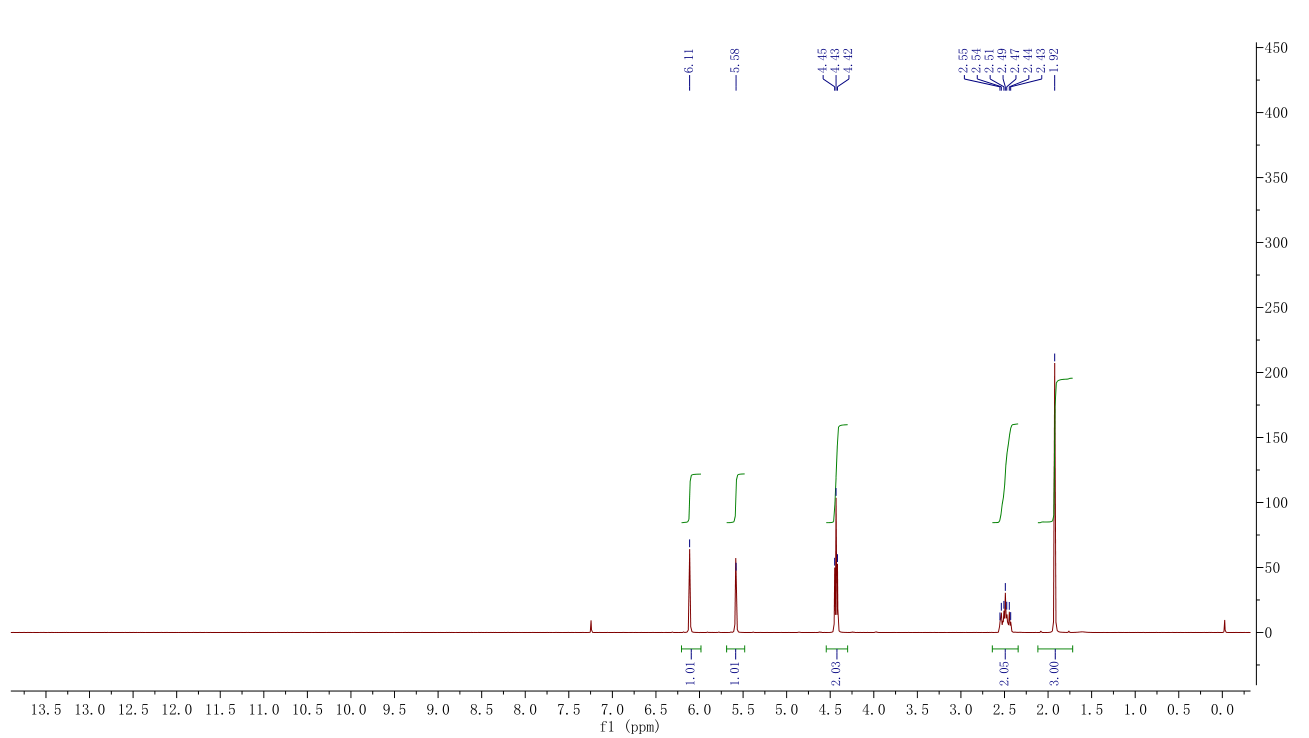2-(Perfluorooctyl)ethyl methacrylate CAS#: 1996-88-9; ChemWhat Code: 125808
Identification
| Product Name | 2-(Perfluorooctyl)ethyl methacrylate |
| IUPAC Name | 3,3,4,4,5,5,6,6,7,7,8,8,9,9,10,10,10-heptadecafluorodecyl 2-methylprop-2-enoate |
| Molecular Structure | |
| CAS Registry Number | 1996-88-9 |
| EINECS Number | 217-877-2 |
| MDL Number | MFCD00042307 |
| Synonyms | 3,3,4,4,5,5,6,6,7,7,8,8,9,9,10,10,10-heptadecafluorodecyl methacrylate, 3,3,4,4,5,5,6,6,7,7,8,8,9,9,10,10-heptadecafluorodecyl methacrylate, 1H,1H,2H,2H-heptadecafluorodecyl methacrylate, 1H,1H,2H,2H-Perfluorodecyl methacrylate, 2-(perfluorooctyl)ethyl methacrylate, Perfluorooctyl-ethylene methycrylate, heptadecafluorodecyl methacrylate |
| Molecular Formula | C14H9F17O2 |
| Molecular Weight | 532.193 |
| InChI | InChI=1S/C14H9F17O2/c1-5(2)6(32)33-4-3-7(15,16)8(17,18)9(19,20)10(21,22)11(23,24)12(25,26)13(27,28)14(29,30)31/h1,3-4H2,2H3 |
| InChI Key | HBZFBSFGXQBQTB-UHFFFAOYSA-N |
| Canonical SMILES | CC(=C)C(=O)OCCC(C(C(C(C(C(C(C(F)(F)F)(F)F)(F)F)(F)F)(F)F)(F)F)(F)F)(F)F |
| Patent Information | ||
| Patent ID | Title | Publication Date |
| US2003/194378 | Novel aerosol formulation containing a polar fluorinated molecule | 2003 |
Physical Data
| Appearance | Colorless liquid |
| Density | 1.596 g/mL at 25 °C |
| Boiling Point, °C | Pressure (Boiling Point), Torr |
| 51 | 0.3 |
Spectra
| Description (NMR Spectroscopy) | Nucleus (NMR Spectroscopy) | Solvents (NMR Spectroscopy) | Temperature (NMR Spectroscopy), °C | Comment (NMR Spectroscopy) |
| Chemical shifts | 1H | CDCl3 | 300 | |
| Chemical shifts | 13C | CDCl3 | 75 | |
| Spin-spin coupling constants | CDCl3 | 1H-1H, 19F-1H. | ||
| Chemical shifts | 1H | CDCl3 | 25 | |
| Chemical shifts | 1H |
| Description (Mass Spectrometry) |
| electrospray ionisation (ESI), spectrum |
Route of Synthesis (ROS)
| Conditions | Yield |
| With dipotassium hydrogenphosphate; [4,4’-bis(1,1-dimethylethyl)-2,2’-bipyridine-N1,N1‘]bis [3,5-difluoro-2-[5-(trifluoromethyl)-2-pyridinyl-N]phenyl-C]iridium(III) hexafluorophosphate; triphenylphosphine In dichloromethane; water at 20℃; for 48h; Inert atmosphere; Irradiation; Experimental Procedure Firstly weighing (13.6 mg, 0.1 mmol),photocatalyst Ir[dF(CF3)ppy]2(dtbbpy)PF6(2.3 mg, 0.002 mmol), K2HPO4(3.5 mg, 0 . 02 mmol),and Ph3P (31.5 mg, 0.12 mmol)are added to a reaction tube, pumping air through the vacuum line three times, in the argon atmosphere, adding DCM/H2O (2.0 ml, 4:1 v/v), then carefully added (79.8 mg, 0.15 mmol),then put into 5W blue LEDs lamp irradiation, react at room temperature for 48 h.Add 20 ml water, and the DCM extraction (3x 10 ml) the aqueous phase, combined with the organic phase. The organic phase by absolute Na2SO4 after drying and steaming and to remove the solvent, dry sample, column chromatography (300 – 400 item of chromatographic analysis silica gel) (petroleum ether – ethyl acetate) to obtain the product 45.6 mg, Yield 70%. | 70% |
Safety and Hazards
| Pictogram(s) |    |
| Signal | Danger |
| GHS Hazard Statements | H314 (97.5%): Causes severe skin burns and eye damage [Danger Skin corrosion/irritation] H317 (97.5%): May cause an allergic skin reaction [Warning Sensitization, Skin] H318 (95%): Causes serious eye damage [Danger Serious eye damage/eye irritation] H334 (97.5%): May cause allergy or asthma symptoms or breathing difficulties if inhaled [Danger Sensitization, respiratory] Information may vary between notifications depending on impurities, additives, and other factors. |
| Precautionary Statement Codes | P260, P261, P264, P272, P280, P285, P301+P330+P331, P302+P352, P303+P361+P353, P304+P340, P304+P341, P305+P351+P338, P310, P321, P333+P313, P342+P311, P363, P405, and P501 (The corresponding statement to each P-code can be found at the GHS Classification page.) |
Other Data
| Transportation | NONH for all modes of transport |
| Under the room temperature and away from light | |
| HS Code | 291614 |
| Storage | Under the room temperature and away from light |
| Shelf Life | 1 year |
| Market Price | USD |
| Druglikeness | |
| Lipinski rules component | |
| Molecular Weight | 532.197 |
| logP | 8.664 |
| HBA | 2 |
| HBD | 0 |
| Matching Lipinski Rules | 2 |
| Veber rules component | |
| Polar Surface Area (PSA) | 26.3 |
| Rotatable Bond (RotB) | 12 |
| Matching Veber Rules | 1 |
| Use Pattern |
| It is an important intermediate for the production of surface protective agents |
| It is used in the fields of textiles |
| It is used in the coatings. |
| It is used in fluorosurfactants. |
Buy Reagent | |
| No reagent supplier? | Send quick inquiry to ChemWhat |
| Want to be listed here as a reagent supplier? (Paid service) | Click here to contact ChemWhat |
Approved Manufacturers | |
| Warshel Chemical Ltd | http://www.warshel.com/ |
| Want to be listed as an approved manufacturer (Requires approvement)? | Please download and fill out this form and send back to approved-manufacturers@chemwhat.com |
Other Suppliers | |
| Watson International Limited | Visit Watson Official Website |
Contact Us for Other Help | |
| Contact us for other information or services | Click here to contact ChemWhat |



